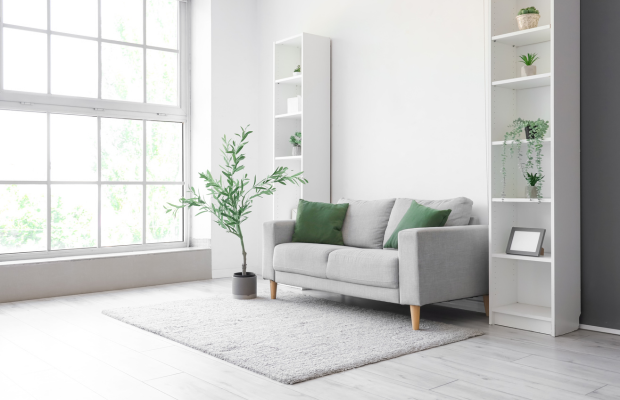Converting a part of your property into a more usable space is a great way to futureproof your home and add value.
But property
conversion isn’t always straightforward and there’s a lot to consider.
From loft and garage conversions to basement and barns, this guide tells you everything you need to know…
Loft conversions
If you’re thinking about adding more bedroom and bathroom space to your home, a loft conversion can be a great way to achieve that.
And by being creative with the space you have available, you may also be able to squeeze a home office into your new top-floor.
Things to consider before taking on a loft conversion
Not all loft spaces are suitable for conversion, while others may require additional (and expensive) structural work to make the space usable.
To assess your loft space’s suitability for conversion, you should consider:
- The available head height
- The pitch of your roof
- The structure of your roof
- The position of chimney stacks or a water tank
Your loft should have an available head height of at least 2.2 metres for a conversion to work, although there are some solutions for spaces of less than this height.
Modern ‘W’ shaped roof structures, meanwhile, are often harder to convert, as rafters will need to be replaced with an ‘A’ shaped structure to create the hollow space required for a conversion.
That can mean additional structural support is required, which can be expensive.
Can you convert a loft without planning permission?
Most loft conversions fall under Permitted Development, so don’t require planning permission.
However, there are rules under Permitted Development that your project will need to stick to.
That means your loft conversion:
- Must not add more than 40 cubic metres of volume to your property if it’s a terraced house, or 50 cubic metres if it’s a semi-detached or detached home
- Must not exceed the existing height of your roof
- Cannot extend beyond the existing roof slope where your property fronts a road
- Cannot have a veranda or balcony
If you wish to exceed these rules, you’ll require planning permission.
And if your property is in a conservation area or Area of Outstanding Natural Beauty, Permitted Development rights may be limited, meaning you’ll require planning approval for a loft conversion.
You may also have to notify your neighbours of any proposed work under the Party Wall Act if you live in a terraced or semi-detached house.
What does a loft conversion cost?
Loft conversions can range in cost from around £20,000 to £65,000 for more complex work.
The cheapest loft conversions are those where the loft space is 100% suitable for conversion.
That’s because fewer structural interventions will be required to make the space safe.
Does a loft conversion add value?
Adding additional space to your property through a loft conversion could add between 10% and 20% to the value of your home when you come to sell.
However, overspending on your project or property ceiling prices where you live could impact this.
Garage conversions
Garage conversions are another popular way of adding space to a property – particularly an additional bedroom with en-suite or a children’s playroom.
Things to consider before starting a garage conversion
The first thing to do before committing to a garage conversion is to weigh up your need for additional internal space against how you use your existing garage.
If you have only a small amount of off-street parking and use your garage as a home for your car, what will the impact be?
Or if you use your garage for storage, where will you put things once the space has been converted, or are you willing to have a clear-out?
Do you need planning permission to turn a garage into a room?
Most garage conversions fall under Permitted Development, so won’t require planning permission.
However, if Permitted Development rights have been restricted or removed because you live in a conversation area or Area of Outstanding Natural Beauty, you may require planning consent to convert your garage – so always check with your local authority before starting work.
Some modern homes, particularly those on estates of homes, also have covenants that state garages must be retained as parking.
Check your property deeds to find out if this is the case.
Is it worth it to convert a garage?
If your need for more internal space is greater than your need for a garage, converting can be a great thing to do.
Adding additional square footage to your property through a garage conversion could increase your home’s value and may also help to futureproof it as your family grows – meaning you may be able to stay in your property for longer.
How much is a garage conversion?
A garage conversion can be one of the cheapest ways to add space to your home.
If your garage structure is good and the space in good condition, you may be able to convert it for around £7,000 to £10,000.
However, your overall costs will depend on the finish you want and the space you want to create.
For example, creating a high-spec bathroom is likely to cost more than creating an additional bedroom space.
Basement conversions
Of all property conversion options, basement conversions are the rarest in the UK.
However, in period homes, such as many of those in London, basements are more common, and many are great options to add more space.
Things to consider with basement conversions
There are lots of things to consider before embarking on a basement conversion project.
Because basements often require lots more waterproofing and flooding protection work, they can be more complicated and more expensive to achieve.
You’ll also need to consider:
- Basement access
- Ceiling height
- The need for windows and natural light
- Any waterproofing or flooding concerns
Planning permission for basement conversions
If you’re converting an existing basement space and not excavating or making major changes, your basement conversion is likely to fall under Permitted Development.
However, basements can be complex, so it’s always best to check with your local planning department before committing to a project.
If your property is connected to another, for example a terraced or semi-detached home, you may need to inform your neighbours of your plans under the Party Wall Act.
How much does a basement conversion cost?
Often the biggest cost when converting an existing basement into a new living space is waterproofing.
There are various options for waterproofing a basement, including:
- A plastic Cavity Drainage Membrane (CDM) and pump
- A tanking slurry to seal walls and floors
A straightforward basement conversion with no ceiling height or floor height changes could cost in the region of £1,500 per square metre.
However, the overall cost will depend on what you plan to do with the space, with kitchens and bathrooms costing more due to the need for additional services.
Barn conversions
Whether you already own a barn you’d like to convert, or you’re looking to buy one to renovate and live in, barn conversions can make truly stunning homes.
Are barn conversions a good investment?
Barn conversions are hugely popular with buyers seeking lots of space in a rural location.
They’re also unique and hold their value well, meaning converting a barn can be a great investment.
What you’ll need to consider with a barn conversion
Because an existing barn isn’t classed as a ‘habitable’ building, there are lots of financing considerations you’ll need to make before taking one on as a project.
Traditional mortgages aren’t available to buy and renovate a barn, so you may need to consider development finance such as a bridging loan or self-build mortgage.
Bridging loans usually come with higher interest rates, while the number of self-build mortgages available is limited. Chat to a qualified mortgage advisor for more information.
Do I need planning permission to convert a barn?
Planning permission rules around barn conversions were changed in 2014, with a new planning class created.
Under Class Q rules, many barn conversions fall under Permitted Development rights and don’t require planning permission.
However, planning permission will be required if:
- The barn you’re converting is in an Area of Outstanding Natural Beauty
- The barn is a listed building
- The barn is on non-agricultural land
- Under the Class Q rules, you’ll still need to inform the local authority about your plans.




